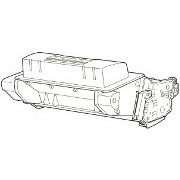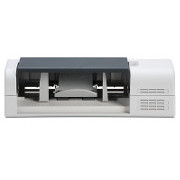HP P4014, P4015 and P4515 Printer Accessories.
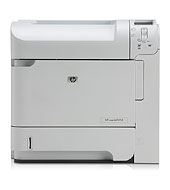
The P4014 series printers were introduced in early 2008 and on the market until 2011. The series includes the :
- P4014 and P4015 - (sometimes rather confusingly called the P4010 series)
- P4515 (sometimes called the P4500 series although it is the only member of the "family" )
They can all take the same accessories although it wasn't normal to equip a P4014 with the full range simply because if you are going to spend several thousand pounds on accessories you might as well have the full speed printer that can take big cartridges.
All of the M601 accessories are backward compatible with the P4014 series. Output devices will need a firmware upgrade if they are first used on an M601 then moved to a P4014 machine. The CE997A Mailbox, CE404A Stacker and CE405A stapler Stacker. See HP's note: HP LaserJet Enterprise M600 Printer Series - Accessory Compatibility.
We have sold M601 accessories such as the 500 Sheet feeder CE998A to people with P4014 printers. However we have reservations because of reports that firmware upgrade 04.170.3 can break compatibility.
The P4014 series printers were replaced in the market in 2011.The replacement models are the LaserJet Enterprise 600 M601 ,M602 and M603; the printers give much the same print speeds with a few improved features.
The P4014 had a range of accessories: expansion paper feeder units that sit under the printer, an envelope feeder, stapler, staple/stacker and a 5 bin mailbox unit. There is also a stand which is needed if the machine has a range of these things fitted since it becomes quite tall. Internal accessories include expansion memory and things like USB pens which can contain fonts and forms.
When HP introduced the M601 series it withdrew the accessories listed here; however the new series of accessories are supposed to work with the older printer. The older accessories don't work (or not necessarily) with the newer printer. The specifications and indeed the mechanics remain the same. The older parts are usually only available as a "refurb" and from eBayers selling ancient stock. If you have a mixed fleet of printers to support the newer accessories may cost more but are probably better value.
The table shows the P4014 series parts and their M601 series substitutes. Both always look identical.
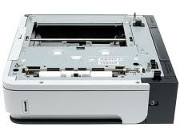 HP CB518A 500 sheet feeder or CE998A | 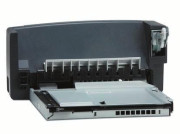 HP CB519A duplexer or CF062A | 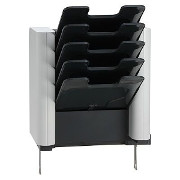 HP CB520A 5-bin mailbox or CE997A HP CB520A 5-bin mailbox or CE997A | 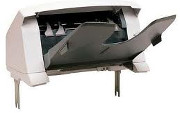 HP CB521A stacker or CE404A |
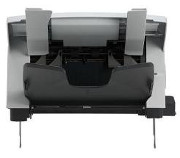 HP CB522A stapler-stacker or CE405A | 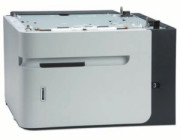 HP CB523A 1500 sheet input feeder or CE398A | 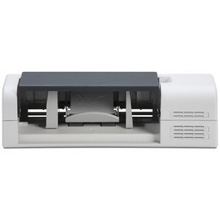 HP CB524A 75-sheet envelope feeder or CE399A |  HP CB525A printer stand used by P4014, M601 and M604. |
 HP CB527A custom media cassette used by P4014 and M601. |  HP CE483A 512MB memory used by P4014 and M601. |
Accessories
Printer accessories are things some customers need but others can do without.
Accessories are a feature of larger printers. Small printers make no provision for them, there are one or two built in input trays and one output tray. The budget doesn't even run to adding a memory slot. Larger printers are a platform for adding extra paper handling devices. One of the ways copiers are compared is simply to note the maximum paper capacity - it often proves a surprisingly good indicator of a machine's overall capabilities.
The P4014, M601 and M605 printers have a maximum capacity at jut 3,600 sheets - compared with some copiers they are mere wannabes or perhaps we should say "nicely judged and highly capable at the price".
Accessories change with time.
Networking
Fifteen years ago there were discussions about whether everyone would want a network card; HP JetDirect cards then cost £200+ and were only normal on high end kit like the then-new LaserJet 4350. The cost of a network port on a PC had already fallen to "trivial" because they were always wanted, but many people preferred not to share printers or use a "Windows Share" because it was easier to set up. Even in 2008 there was a base model LJ-P4014 that had only USB, no network port. By 2011 networking was compulsory on the LJ-M601, no model omitted it. Ethernet is universally provided on office printers.
Wireless
Wireless network capability is rather different. WiFi and NFC are often provided on home printers but are quite new on office printers. Many IT managers don't see much purpose in WiFi connectivity for printers; after all the printer isn't going to move offten, it is far from portable. If something wants to print then it can join the wired network. The vagaries of wireless connections are added hassle.
Wireless print may become essential with the number of tablet and mobile phone based devices needing to print. New LJ-M605x and M606x printers offer it. For a new printer the cost of implementing WiFi and NFC is just a chip and some extra firmware, as wired networking once was. Within a couple of years every printer is likely to have wireless capabilities with the main problem being to disable it where it is unwanted.
Chips cost very little ; the cost of mechanical things mounts up very quickly.
Duplex
Automatic double-sided print or "duplexing" wasn't all that common in the 1990s. HP tested the market for duplexing with machines like the LJ-4000 in 1998 and found it proved popular - so today most office-quality laser printers (and many home inkjets) sell with a duplexer built in or as part of a "bundle" . Printers with duplexing and network are often called the "DN" models. What was once an accessory can become a standard item.
Multifunction
Document scanners have been the big success in printer add-ons. Scanners have succeeded as built in devices rather than accessories. Physically it gives a convenient package and it works well conceptually as well, people think of it as a copier.
From the mid-1970s on there have been predictions of paperless offices, but so far it hasn't happened. Reading things on paper is better than reading on the screen. Being able to highlight and mark the paper is flexible in a way screen note-taking software like Evernote and Onenote struggle to imitate. Then there are papers qualities as an aid to memory - a piling system rather than a filing system.
Turning a printer into a copier is not necessarily expensive. The CCD or CMOS array that is the basis of a scanner is just a rather peculiar chip. A flatbed scanner has the chip and a bright light, some lenses, a little bit of mechanics and a drive motor. Combine a scanner with a printer and you have a machine that can easily double as a copier, fax, computer scanner and the document-sender part of a workflow system.
Copiers became a key piece of office machinery twenty years before the market for computer printers took off. Little printers have made the home All-In-One copier not just practical but popular. Rather larger machines are called MFPs (Multi Function Printers) and big machines are often called "Digital Copiers" to distinguish them from the (largely obsolete) analogue copiers.
A printer is essentially a computer which comes with motors and cogs delivering a particular print technology. It can have any computer or mechanical attachment that makes sense. For instance, quite a few printers are getting large screens so people can select documents to print, release them from a print queue or modify them in some way - switching to duplex or two-up print to save paper for instance.
Making printers into platforms for accessories has implications for how they work; they need an operating system. Printers have always had to multitask, making up dot patterns whilst handing communications, reading sensors and controlling motors but early printers did this without a recognised operating system. Now there is an embedded OS.
Curiously, there isn't a dedicated scanner attachment for the P4014, the M601 or the new M603 series. If you want a scanner to match the printer then something like the Flow 5000s2 might be appropriate.
CA multifunction version of the P4014 / M601 is available as the M4555MFP and of the M603 series the P4014's faster descendant the M630 MFP. These look rather different because the print engine is turned sideways but they work in a similar manner and take their siblings cartridges.
Printer and Accessory Prices
People are naturally resistant to paying more for the accessories than they did for a printer. This may be the wrong way to look at things. Printers are mass produced, made in millions, widely used and most importantly largely paid for through sales of ink. Printers are therefore weirdly cheap.
Accessories aren't all like that. Accessories are more like post-room and print-works equipment, made in hundreds and needed for special tasks. Printer manufacturers probably don't subsidise the price of the accessories. You won't necessarily do more printing because you have an envelope feeder or a stapler-stacker: you’re workflow will just be more efficient and professional.
If you look at the price of things like paper joggers and automatic staplers bought as office equipment it is quite spectacular. A Jogger can be over £800 and a good quality electric stapler £500 plus.
If you dismantle one of these things the reason for the costs becomes a bit more evident, they are quite elaborate.
So whilst it may seem odd that printer accessories can cost more than the machine itself that needs to be weighed against the time they save. Envelopes can be fed from the MP tray but it takes about 7 whilst the automatic envelope feeder reliably handles 70 at a time.
Copyright G & J Huskinson & MindMachine Associates Ltd 2013, 2015. Some pictures derived from HP User and Service guides. These technical pages do not constitute an offer for sale; just our knowledge at the time of writing. See the catalog. Sales pages on this Web site use cookies to store user information. We also use Google Analytics to track site useage patterns.

